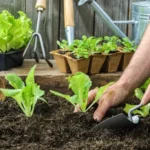If you’re planning a garden in Ohio knowing your garden zone is key to success. Garden zones help you understand which plants will thrive in your area based on climate and temperature. Ohio’s diverse climate means its garden zones vary across the state, so pinpointing your exact zone can make all the difference.
Understanding your garden zone lets you choose the right plants that can survive winters and flourish through the growing season. It saves you time and money by avoiding plants that won’t thrive in your region. Whether you’re a seasoned gardener or just starting out, knowing Ohio’s garden zones will help you create a vibrant and healthy garden all year round.
Understanding Garden Zones
Garden zones categorize regions based on climate factors like minimum winter temperatures. Knowing your zone helps you match plants to your local conditions.
What Are Garden Zones?
Garden zones, defined by the USDA Plant Hardiness Zone Map, divide areas into 13 zones based on average annual minimum temperatures. Each zone spans a 10°F temperature range. For example, Ohio falls mainly in zones 5b to 6b, where winter lows range from -15°F to 5°F. Zones guide you in selecting plants that can survive cold winters without damage.
Importance of Knowing Your Garden Zone
You save resources by choosing plants adapted to your zone’s climate, minimizing losses from frost or heat stress. Understanding your zone helps you plan planting times and protect sensitive species when temperatures drop. Planting outside your zone often requires extra care or protective measures, increasing maintenance efforts. Gardening success in Ohio hinges on selecting hardy plants suited to zones 5b through 6b.
What Garden Zone Is Ohio?
Ohio falls mainly within USDA hardiness zones 5b to 6b. Knowing this helps you select plants that survive winter lows and grow well in your local climate.
Overview of Ohio’s Climate
Ohio’s climate features cold winters and warm summers. Winter temperatures typically drop between -15°F and 5°F. Humidity varies through the seasons, with moderate rainfall supporting diverse plant growth. This climate makes hardy plant selection vital for successful gardening.
USDA Hardiness Zones in Ohio
The USDA Plant Hardiness Zone Map places Ohio primarily in zones 5b, 6a, and 6b.
| Zone | Minimum Winter Temperature (°F) |
|---|---|
| 5b | -15 to -10 |
| 6a | -10 to -5 |
| 6b | -5 to 0 |
Understanding your zone prevents planting species that fail in winter cold or struggle in summer heat.
Regional Variations Within Ohio
Northern Ohio experiences colder winters, placing areas like Cleveland in zone 5b. Southern Ohio, including Cincinnati and Columbus, lies mostly in zones 6a and 6b because of milder winters. Elevation and urban heat also affect microclimates, influencing plant hardiness within local neighborhoods. Identifying your exact zone refines plant choices and garden plans.
How to Use Ohio’s Garden Zone Information
Understanding your garden zone in Ohio guides you in selecting plants that thrive in your area’s climate. Apply this knowledge to make informed choices that improve your garden’s health and productivity.
Choosing Plants Suited for Ohio
Select plants rated for zones 5b to 6b to ensure survival through Ohio’s winter lows, which range from -15°F to 0°F. Choose perennials, shrubs, and trees labeled hardy within these zones. Opt for native species like Ohio buckeye or black-eyed Susan for increased resilience. Avoid plants that require warmer zones; they risk winter damage or failure to thrive. Use local extension services or nurseries to confirm plant hardiness for your specific zone.
Tips for Successful Gardening in Ohio Zones
Start planting after the last expected frost date in your zone to protect young plants. Adjust watering based on seasonal rainfall and humidity levels typical to Ohio’s climate. Use mulch to moderate soil temperature and retain moisture during hot summers. Monitor for microclimate effects, especially in urban areas or higher elevations, to adapt care accordingly. Protect sensitive plants with covers during unexpected cold snaps below your zone’s average minimum temperatures.
Conclusion
Knowing your garden zone in Ohio gives you a clear advantage when planning your garden. It helps you pick plants that can handle the local climate, making your gardening efforts more successful and rewarding.
By tailoring your plant choices and care routines to your specific zone, you’ll create a thriving garden that stands strong through seasonal changes. This knowledge not only saves you time and money but also ensures your garden flourishes year after year.

Hi, I’m Md Rofiqul, a gardening enthusiast who loves spending time in the garden and backyard. I enjoy caring for plants, growing flowers and vegetables, and creating a green space that feels peaceful and refreshing. Gardening is more than just a hobby, it’s a passion that connects me to nature and brings joy to my daily life. Living with plants inspires me to embrace simplicity, patience, and sustainability while making every day more colorful and rewarding.

